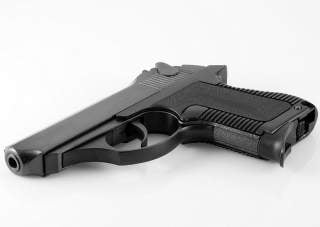This Gun Can Pierce a Bullet Proof Vest (With a Big Catch)
If you are really, really close.
The 5.45-by-18-millimeter Russian Pistolet Samozaryadny Malogabaritny — “compact self-loading pistol”—is a small pistol for concealed carry. Emphasis on small. The Tula Design Bureau designed the PSM in the late 1960s as an alternative to the standard Makarov.
Developed for use by general officers and intelligence operatives, the PSM was accepted by the Soviet government in 1972. Production began at Izhevsk a year later. Members of the Politburo and KGB often carried the tiny weapon.
The PSM’s design is simple. Its action — the standard blowback type. Its most interesting features are its thinness and the proprietary 5.45-by-18-millimeter ammunition.
The PSM is just 17 millimeter wide and 15.5 centimeters long and weighs 460 grams, making it thinner but heavier than a modern Glock 42. The slide and frame are milled from steel while, in early models, the grips are made of aluminum. Later models feature plastic grip panels.
The frame and slide are smooth and flat in order to minimize the pistol’s profile and prevent any snagging on clothing. The slide-mounted, combined safety and decocker is flat and protrudes upward at the rear of the slide so as not to increase the pistol’s width.
This, in theory, also allows the operator to switch off the safety and cock the hammer in one fluid motion.
Externally, the pistol’s profile is reminiscent of the Walther PPK. Indeed, the disassembly process is similar to that of the Walther. But the PSM is an even more compact weapon than the PPK is. It feeds from a lightweight, single-stack magazine with open sides, similar to the Makarov’s own magazine.
The PSM has a heel magazine-release rather than a push button in the frame, in order to further reduce the pistol’s profile.
The magazine holds eight rounds. The round itself includes a jacketed spitzer-style projectile in an interesting necked case. The 38.6-gram projectile can achieve a velocity of 320 meters per second, making it effective against Kevlar — but only at close range. At longer ranges, the round lacks stopping power.
Izhevsk also manufactured an export version of the pistol chambered in .25 ACP that it dubbed the IZh-75. In the 2000s, Ukraine also began manufacturing a non-lethal version, the PSM-R, that it chambered for nine-millimeter rubber rounds.
This article by Matthew Moss originally appeared at War is Boring in 2017.
Image: Wikimedia

